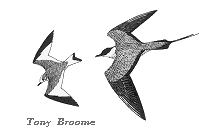October
Many land birds migrate
within, to and from this country in October. Birds you see everyday in your
garden such as Greenfinches, Chaffinches, Robins, Starlings and Wood Pigeons
making some remarkably long journeys. Many of these birds follow the
coastline which is the best place to see this visible migration. Pick an
overcast day with light south east winds, get to the coast at dawn and for
the next two hours you should be rewarded with a stream of birds passing
overhead on their way south. Some good spots on the Dee are
Red Rocks,
Denhall Quay, Hilbre Island and
Point of Ayr.
The Dee Estuary is one of the most important sites in this country for
Shelduck, Redshank and Curlew - all three of these species are usually at
peak numbers during October. Between 10,000 and 14,000 Shelduck will be on
the estuary and most of these will be off
Thurstaston at low tide, and nearby
Heswall at high tide - an amazing sight.
Heswall is also the best place to see the Redshank and Curlew, but good
numbers of Redshank also congregate at
Connah's Quay.
Like September strong north-west winds mean some great sea-watching, in
particular massive movements of auks - Guillemots and Razorbills - with peak
movements of several hundred per hour. Cormorants have been steadily
increasing in the estuary over the past 15 years. They are present all year
round but peak in the autumn with up to 700 birds. One of the best times to
see them is at low tide roosting on the sand banks.

November
The Dee Estuary is of international importance for
Black-tailed Godwits with a peak of over 4,000 in November. Most of these
can be seen at
Connah's Quay
in the first half of the month after which they disperse with about half
going over to the English side between Caldy
and Heswall. These Godwits breed in
Iceland and the ones which over summer here are immature birds.
November sees the last of the really big high tides of the year. Given low
atmospheric pressure and a west wind the water will cover the marsh at the
head of the estuary resulting in some spectacular birdwatching. Short-eared
Owls and Water Rails are driven from the marsh and there can be huge numbers
of duck feeding on the seeds from all the marshland plants. Flocks of
Pintail, Teal and Wigeon, each 5,000 strong, can occur. The Dee Estuary is
the most important site in the country for Pintail. Many of these duck,
especially Pintail, can also be seen at low tide from
Flint Point where they loaf on the sand
banks across the channel of the River Dee.
This month sees the return of Knot and Dunlin in large numbers, best seen at
Leasowe at low tide or Hoylake and
Point of Ayr at high tide. Purple Sandpipers
return to
Hilbre
Island, with 20 or so in November increasing to over 40 by the new year.
Snow Buntings should also return, either at
Gronant, Point of Ayr,
Hilbre
or the north Wirral coast. Some years we get
flocks over 20 strong, other years just 2 or 3. A cold snap can result in
some spectacular movement of birds with large flocks of Lapwing, Skylark,
Redwing and Fieldfare passing over.

December
Although there has been a drastic drop in breeding Lapwing in this country
over wintering numbers remain steady on the estuary with an influx of
continental birds. Most years we get a peak of over 8,000 in December, but
freezing weather to the east may bring in much larger numbers. Their untidy
flocks make a spectacular sight tumbling over the sky. Golden Plovers often
associate with Lapwings and we can get several hundred in a good year,
mainly at Burton.
Although not as regular as they used to be we sometimes get a Hen Harrier or
two overwintering. They can be seen during the day patrolling the marsh, but
the best time to see them is at dusk coming in to roost - traditionally in
the reed bed just off the car park at Parkgate
Old Baths.
Water Pipits are regular at Neston Old Quay.
But Rock Pipits, which also winter there, are consistently being
misidentified as Water Pipits - so beware! That lovely duck, the Smew,
usually appears during December - just one or two either at
Inner Marsh Farm or
Shotwick Boating Lake.
Some winters we can get huge flocks of Dunlin and Knot feeding at
Leasowe at low tide and moving to
Hoylake
to roost, up to 30,000 of the former and a remarkable 50,000 of the latter.
Ringed Plover and Sanderling are also present but in much smaller numbers,
200 or so, but make a lovely sight busy scurrying around the sand feeding in
front of the main roosting flocks. |

